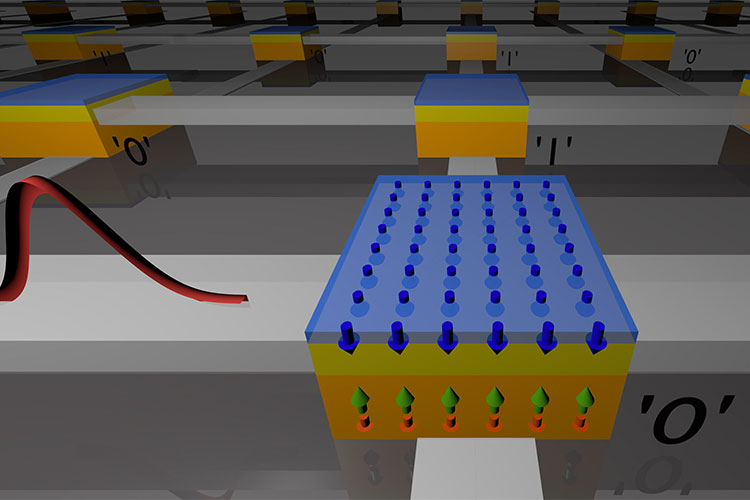Ultrafast magnetic reversal points the way toward speedy, low-power computer memory
Breakthrough that could lead to greatly increased performance and more energy-efficient computer memory and processing technologies
November 3, 2017

In this schematic of a magnetic memory array, an ultrafast electrical pulse switches a magnetic memory bit.
Researchers at UC Berkeley and UC Riverside have developed a new, ultrafast method for electrically controlling magnetism in certain metals, a breakthrough that could lead to greatly increased performance and more energy-efficient computer memory and processing technologies.
The findings of the group, led by Berkeley electrical engineering and computer sciences (EECS) professor Jeffrey Bokor, are published in a pair of articles in the journals Science Advances (Vol. 3, No. 49, Nov. 3, 2017) and Applied Physics Letters (Vol. III, No. 4, July 24, 2017).
Computers use different kinds of memory technologies to store data. Long-term memory, typically a hard disk or flash drive, needs to be dense in order to store as much data as possible. But the central processing unit (CPU) — the hardware that enables computers to compute — requires its own memory for short-term storage of information while operations are executed. Random Access Memory (RAM) is one example of such short-term memory.

Jeffrey Bokor
Reading and writing data to RAM needs to be extremely fast in order to keep up with the CPU’s calculations. Most current RAM technologies are based on charge (electron) retention, and can be written at rates of billions of bits per second (or bits/nanosecond). The downside of these charge-based technologies is that they are volatile, requiring constant power or else they will lose the data.
In recent years, magnetic alternatives to RAM, known as Magnetic Random Access Memory (MRAM), have reached the market. The advantage of magnets is that they retain information even when memory and CPU are powered off, allowing for energy savings. But that efficiency comes at the expense of speed. A major challenge for MRAM has been to speed up the writing of a single bit of information to less than 10 nanoseconds.
“The development of a non-volatile memory that is as fast as charge-based random-access memories could dramatically improve performance and energy efficiency of computing devices,” says Bokor. “That motivated us to look for new ways to control magnetism in materials at much higher speeds than in today’s MRAM.”
“Inspired by recent experiments in the Netherlands on ultrafast magnetic switching using short laser pulses, we built special circuits to study how magnetic metals respond to electrical pulses as short as a few trillionths of a second,” or picoseconds, says coauthor Yang Yang, who earned his master’s degree and Ph.D. in materials science and engineering at Berkeley. “We found that in a magnetic alloy made up of gadolinium and iron, these fast electrical pulses can switch the direction of the magnetism in less than 10 picoseconds. That is orders of magnitude faster than any other MRAM technology.”
“The electrical pulse temporarily increases the energy of the iron atom’s electrons,” says Richard Wilson, currently an assistant professor of mechanical engineering at UC Riverside who began his work on this project as a postdoctoral researcher in EECS at Berkeley. “This increase in energy causes the magnetism in the iron and gadolinium atoms to exert torque on one another, and eventually leads to a reorientation of the metal’s magnetic poles. It’s a completely new way of using electrical currents to control magnets.”
After their initial demonstration of electrical writing in the special gadolinium-iron alloy, the research team sought ways to expand their method to a broader class of magnetic materials. “The special magnetic properties of the gadolinium-iron alloy are what makes this work,” says Charles-Henri Lambert, a Berkeley EECS postdoc. “Therefore, finding a way to expand our approach for fast electrical writing to a broader class of magnetic materials was an exciting challenge.”
Addressing that challenge was the subject of a second study, published in Applied Physics Letters in July. “We found that when we stack a single-element magnetic metal such as cobalt on top of the gadolinium-iron alloy, the interaction between the two layers allows us to manipulate the magnetism of the cobalt on unprecedented time-scales as well,” says Jon Gorchon, a postdoctoral research in the Materials Sciences Division at Lawrence Berkeley Lab and in EECS at UC Berkeley.
“Together, these two discoveries provide a route toward ultrafast magnetic memories that enable a new generation of high-performance, low-power computing processors with high-speed, non-volatile memories right on chip,” Bokor says.
Additional team members include Akshay Pattabi, a Berkeley EECS Ph.D. candidate, and Berkeley EECS professor Sayeef Salahuddin. The research was supported by grants from the National Science Foundation and the U.S. Department of Energy.